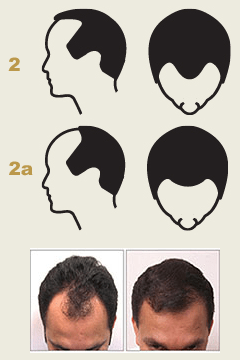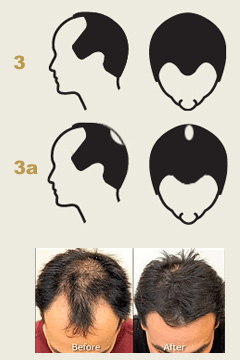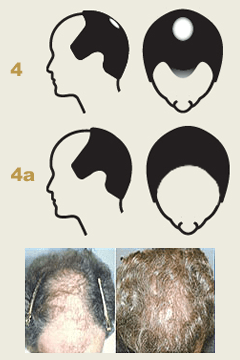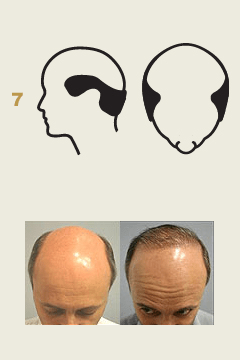Classifying Hair Loss

Classify Your Hair Thinning and Loss

Stages of Hair Thinning and Loss
The Norwood Scale breaks male pattern baldness down into seven stages, numbered 1 through 7. Each stage may be further broken down into sub-categories, presenting a dozen total images for comparing the hair thinning in the illustrations to what you see when you look in the mirror.
Class 1
This represents a head with no visible hair thinning. Think of it as the base template.
Class 2
This shows the beginning of some retreat at the temples and possibly the forehead, often referred to as a receding hairline.
Class 3
Temporal recession becomes more pronounced, and the hairline can push back farther from the front.
Class 4
In addition to more recession in the front and at the temples, possibly leading to a pronounced widow’s peak or a deep field of bare skin or sparse hair, advanced hair thinning on the crown can create what is commonly known as a bald spot.
Class 5
The hair thinning at the temples, front hairline, and crown begin to converge at this stage.
Class 6
This image depicts near-total loss on the front, upper sides, and crown of the head. These three areas of bare skin or sparse hair have met, creating an overall appearance of baldness.
Class 7
Hair is gone from the top and front of the head, with just a single remaining strip that runs from one ear, around the back of the head, to the other ear.
How to Use the Norwood Scale
The Norwood Scale can give you an idea of your own hair thinning progression, but you should still visit a professional who can assess the stage that most closely approximates your degree of loss and recommend a treatment that will yield healthy, full, natural-looking results.
What Causes This Progression?
Men who experience male pattern baldness are suffering from a genetic- and hormone-based problem that causes follicles to shrink over time. The hairs that grow from these follicles thin and shorten until they disappear entirely due to a lack of production.
It’s important to note that not all hair thinning and loss is caused by androgenic alopecia. Environmental factors such as diet and stress can cause hair to fall out, as can certain medical conditions, which may trigger rapid or patchy hair loss, create brittle hair, or cause skin irritations. A doctor can help make a diagnosis in these cases.
The Norwood Scale: A Bay Area Hair Loss Resource
The most common cause of hair thinning and loss in men is a hereditary condition known as androgenic alopecia. Though this problem may manifest in a male adult at any age, and it proceeds at its own pace in each individual, it does progress in a known pattern, giving it its more common name: male pattern baldness. Most typically, the recession leads to the creation of an “M” shape at the hairline, which eventually pulls back into a “U,” causing the remaining hair to resemble a horseshoe.
Since the increasing severity of a man’s hair thinning and loss via androgenic alopecia is roughly predictable, hair experts over the years have developed and refined a baldness classification system known as the Norwood Scale, which allows men to find their degree of hair thinning on a standardized chart. Identifying the stage of a man’s hair loss can help him work with professionals, such as Dr. David Lieberman and Dr. Sachin Parikh, to develop the best plan for treatment to preserve his remaining hair and even bring hair back to where it was lost.
Why Two Surgeons Are Better Than One
“We use each other as a sounding board in every procedure which creates a confidence level that every step is the best possible decision for the patient.”
What Can Be Done About Hair Thinning and Loss?
Men with androgenic alopecia have hair preservation and restoration options at every stage depicted on the Norwood Scale. The earlier treatment begins, the more options may be available for ideal results, but some degree of restoration is possible, even for men who have reached Class 7.
Many men find great success with follicular unit extraction, an advanced method that involves taking healthy hair from baldness-resistant areas of the scalp and transplanting it to the areas where hair is thinning or lost. This strategy has been the basis of many treatments throughout the years, but Dr. Lieberman and Dr. Parikh use the latest automated technology and advanced techniques for unparalleled precision and positive results.
Talk to the staff at the L&P Aesthetics Center for Hair Restoration to learn more about non-surgical options to treat hair thinning and loss, including medications, innovative therapies such as L&P Stimulate, and more.
Charting Hair Thinning in Women
Though doctors use the Norwood Scale as the standard for charting hair thinning in men, they use the Ludwig Scale for measuring the progression of androgenic alopecia in women. While male pattern hair loss typically begins as a receding hairline and a growing bald spot, female pattern hair loss is a unique condition and tends to appear as generalized hair thinning on the sides or top of the head.
CLASS 2

2 Mild hair loss concentrated at the hairline and "widow's peak" of the forehead.
-

General Cost of Procedure
$4.5-9K
-

Average length of procedure
5 hours
-

Average number of follicles
750-1500
-

Recovery Time
4-7 Days
As the hair grows in, the microfollicle extraction sites will be camouflaged in most patients. This happens as early as day 4 but can take up to 7 days to comfortably hide the signs of the procedure.
CLASS 3

3 Characterized by deep recessions at the temples. More significant hair loss and thinning of hair on the crown.
-

General Cost of Procedure
$6-12K
-

Average length of procedure
6-8 hours
-

Average number of follicles
1000-2000
-

Recovery Time
1000-2000
As the hair grows in, the microfollicle extraction sites will be camouflaged in most patients. This happens as early as day 4 but can take up to 7 days to comfortably hide the signs of the procedure.
CLASS 4

3 More aggressive recession of the frontal hairline and at the temples. Visible balding at the crown of the head.
-

General Cost of Procedure
$9-12K
-

Average length of procedure
8 hours
-

Average number of follicles
1500-2000
-

Recovery Time
4-7 Days
As the hair grows in, the microfollicle extraction sites will be camouflaged in most patients. This happens as early as day 4 but can take up to 7 days to comfortably hide the signs of the procedure.
CLASS 5

5 Significant hair loss at the crown and hairline. A bridge of hair often separates the frontal hair loss and posterior scalp hair loss.
-

General Cost of Procedure
$10.5-13.5K
-

Average length of procedure
8 hours
-

Average number of follicles
1750-2250
-

Recovery Time
4-7 Days
As the hair grows in, the microfollicle extraction sites will be camouflaged in most patients. This happens as early as day 4 but can take up to 7 days to comfortably hide the signs of the procedure.
CLASS 6

6 Characterized by a horseshoe-shape hair pattern around the crown. The bridge of hair that once separated the front of the head from the crown is almost gone. Sometimes, a few sparse strands persist.
-

General Cost of Procedure
$12-15K
-

Average length of procedure
8 hours
-

Average number of follicles
2000-2500
-

Recovery Time
4-7 Days
As the hair grows in, the microfollicle extraction sites will be camouflaged in most patients. This happens as early as day 4 but can take up to 7 days to comfortably hide the signs of the procedure.
CLASS 7

7 The most advanced stage of hair loss, only a wreath of thin hair remains on the sides and back of the scalp.
-

General Cost of Procedure
$15-18K
-

Average length of procedure
9 Hours
-

Average number of follicles
2500-3000
-

Recovery Time
4-7 Days
As the hair grows in, the microfollicle extraction sites will be camouflaged in most patients. This happens as early as day 4 but can take up to 7 days to comfortably hide the signs of the procedure.






